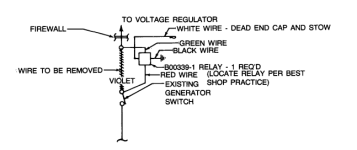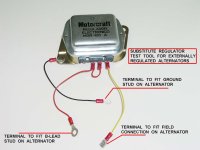Richard RG
Active Member
Recently while happily flying along, noted during one of my panel scans that I had a new project. The voltmeter indicated 12.4v rather than the expected 14.2v it had always indicated. After doing the basic checks confirming I still had an alternator belt and that the belt tension driving the pulley on the Electrosystems 60 amp (PN:ALX8421RS) alternator was correct, then started checking connections/breakers and wiring for continuity, finding no faults.
Being mostly electrically challenged, then downloaded trouble shooting flow sheets from the internet. With the master switch on, then probed for voltages. The battery had been charged up to 12.6v and was able to confirm 12.6v into the Lamar 14v external voltage regulator (PN: B-00267-2) Also installed is a Lamar overvoltage relay module PN B-00339-1 and having 12.6v indicated here as well.
Probing the yellow field wire out of the regulator to the alternator field terminal indicated 6.4v. The alternator field terminal connection indicated 6.4v as well.
My question is, should the field terminal voltage have been within one volt or so of buss voltage? Having zero luck finding specs on the expected field voltage from this regulator powered up and engine off, surmised that 6.4v may be the the correct field voltage to allow the alternator to carry a light load during start up and then ramp up (increase field voltage) alternator load if required, after start up.
Not knowing how to proceed, then decided to confirm if the alternator may be the problem. As per my newly acquired internet education 'full fielded' the alternator. After removing the field wire from the regulator to alternator, installed a jumper wire from the power output terminal of the alternator to the alternator field terminal post. Ensuring that all expensive electrical things wouldn't be exposed to the hoped for high voltage spike started up the engine and instantly pegged the volt meter at 16+ volts.
After confirming that the alternator appeared good. went back to head scratching and probing for voltages again... only to discover that the field voltage out of the regulator is now a solid zero with t 12.6v to the regulator.
It appears at this point that I may need a new regulator as I may have cooked it, due to my full fielding test? I am hoping that the 6.4v field output from the regulator was the source of my no charging issue and no big deal that I may have fried an already semi fried regulator.
I'm hoping someone can confirm (or not) that the regulator was the problem and if so recommend a similar three wire replacement regulator. The current regulator has red power supply wire, black ground wire to airframe and yellow field wire to alternator. Thanks for reading, cheers
Being mostly electrically challenged, then downloaded trouble shooting flow sheets from the internet. With the master switch on, then probed for voltages. The battery had been charged up to 12.6v and was able to confirm 12.6v into the Lamar 14v external voltage regulator (PN: B-00267-2) Also installed is a Lamar overvoltage relay module PN B-00339-1 and having 12.6v indicated here as well.
Probing the yellow field wire out of the regulator to the alternator field terminal indicated 6.4v. The alternator field terminal connection indicated 6.4v as well.
My question is, should the field terminal voltage have been within one volt or so of buss voltage? Having zero luck finding specs on the expected field voltage from this regulator powered up and engine off, surmised that 6.4v may be the the correct field voltage to allow the alternator to carry a light load during start up and then ramp up (increase field voltage) alternator load if required, after start up.
Not knowing how to proceed, then decided to confirm if the alternator may be the problem. As per my newly acquired internet education 'full fielded' the alternator. After removing the field wire from the regulator to alternator, installed a jumper wire from the power output terminal of the alternator to the alternator field terminal post. Ensuring that all expensive electrical things wouldn't be exposed to the hoped for high voltage spike started up the engine and instantly pegged the volt meter at 16+ volts.
After confirming that the alternator appeared good. went back to head scratching and probing for voltages again... only to discover that the field voltage out of the regulator is now a solid zero with t 12.6v to the regulator.
It appears at this point that I may need a new regulator as I may have cooked it, due to my full fielding test? I am hoping that the 6.4v field output from the regulator was the source of my no charging issue and no big deal that I may have fried an already semi fried regulator.
I'm hoping someone can confirm (or not) that the regulator was the problem and if so recommend a similar three wire replacement regulator. The current regulator has red power supply wire, black ground wire to airframe and yellow field wire to alternator. Thanks for reading, cheers






